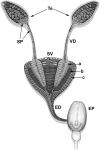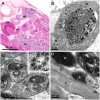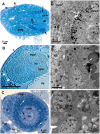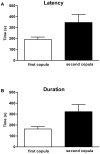Fine structure of the male reproductive system and reproductive behavior of Lutzomyia longipalpis sandflies (Diptera: Psychodidae: Phlebotominae)
- PMID: 24058637
- PMCID: PMC3772895
- DOI: 10.1371/journal.pone.0074898
Fine structure of the male reproductive system and reproductive behavior of Lutzomyia longipalpis sandflies (Diptera: Psychodidae: Phlebotominae)
Erratum in
- PLoS One. 2014;9(1). doi:10.1371/annotation/7d6a463d-41b1-4225-b09b-edecc565071c
Abstract
Background: The male reproductive system of insects can have several tissues responsible for the secretion of seminal fluid proteins (SFPs), such as testes, accessory glands, seminal vesicles, ejaculatory duct and ejaculatory bulb. The SFPs are transferred during mating and can induce several physiological and behavioral changes in females, such as increase in oviposition and decrease in sexual receptivity after copulation. The phlebotomine Lutzomyia longipalpis is the main vector of visceral leishmaniasis. Despite its medical importance, little is known about its reproductive biology. Here we present morphological aspects of the male L. longipalpis reproductive system by light, scanning and transmission electron microscopy, and compare the mating frequency of both virgin and previously mated females.
Results: The male L. longipalpis reproductive system is comprised by a pair of oval-shaped testes linked to a seminal vesicle by vasa deferentia. It follows an ejaculatory duct with an ejaculatory pump (a large bulb enveloped by muscles and associated to tracheas). The terminal endings of the vasa deferentia are inserted into the seminal vesicle by invaginations of the seminal vesicle wall, which is composed by a single layer of gland cells, with well-developed endoplasmic reticulum profiles and secretion granules. Our data suggest that the seminal vesicle acts both as a spermatozoa reservoir and as an accessory gland. Mating experiments support this hypothesis, revealing a decrease in mating frequency after copulation that indicates the effect of putative SFPs.
Conclusion: Ultrastructural features of the L. longipalpis male seminal vesicle indicated its possible role as an accessory gland. Behavioral observations revealed a reduction in mating frequency of copulated females. Together with transcriptome analyses from male sandfly reproductive organs identifying ESTs encoding orthologs of SFPs, these data indicate the presence of putative L. longipalpis SFPs reducing sexual mating frequency of copulated females.
Conflict of interest statement
Figures







References
-
- Araki AS, Vigoder FM, Bauzer LGSR, Ferreira GEM, Souza NA, et al.. (2009) Molecular and behavioral differentiation among Brazilian populations of Lutzomyia longipalpis (Diptera: Psychodidae: Phlebotominae). PLoS Neglect Trop Dis 3: e365. Available: http://www.pubmedcentral.nih.gov/articlerender.fcgi?artid=2628317&tool=p.... Accessed 2013 Aug 16. - PMC - PubMed
-
- Lainson R, Rangel EF (2005) Lutzomyia longipalpis and the eco-epidemiology of American visceral leishmaniasis, with particular reference to Brazil: a review. Mem Inst Oswaldo Cruz 100: 811–827. Available: http://www.bioline.org.br/pdf?oc05169. Accessed 2013 Aug 16. - PubMed
-
- Kelly DW, Dye C (1997) Pheromones, kairomones and the aggregation dynamics of the sandfly Lutzomyia longipalpis Anim Behav 53: 721–731. Available: http://www.sciencedirect.com/science/article/B6W9W-45MFNR4-13/2/b70fce00.... Accessed 2013 Aug 16.
-
- Ward R, Phillips A, Burnet B, Marcondes C (1988) The Lutzomyia longipalpis complex: reprodution and distribution. MW Service, Biosystematics of Haematophagous Insects. Oxford: Oxford University Press. 258–269.
-
- Spiegel CN, Jeanbourquin P, Guerin PM, Hooper AM, Claude S, et al.. (2005) (1S,3S,7R)-3-methyl-alpha-himachalene from the male sandfly Lutzomyia longipalpis (Diptera: Psychodidae) induces neurophysiological responses and attracts both males and females. J Insect Physiol 51: 1366–1375. Available: http://www.sciencedirect.com/science/article/pii/S0022191005001812. Accessed 2013 Aug 16. - PubMed
Publication types
MeSH terms
Substances
Grants and funding
LinkOut - more resources
Full Text Sources
Other Literature Sources

